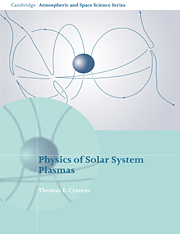Book contents
- Frontmatter
- Contents
- Preface
- Physical constants
- Vector calculus identities
- 1 Space physics
- 2 Introduction to kinetic theory
- 3 Single particle motion and geomagnetically trapped particles
- 4 Magnetohydrodynamics
- 5 Solar physics
- 6 The solar wind
- 7 The solar wind interaction with planets and other solar system bodies
- 8 The magnetosphere
- Appendix
- Index
2 - Introduction to kinetic theory
Published online by Cambridge University Press: 26 October 2009
- Frontmatter
- Contents
- Preface
- Physical constants
- Vector calculus identities
- 1 Space physics
- 2 Introduction to kinetic theory
- 3 Single particle motion and geomagnetically trapped particles
- 4 Magnetohydrodynamics
- 5 Solar physics
- 6 The solar wind
- 7 The solar wind interaction with planets and other solar system bodies
- 8 The magnetosphere
- Appendix
- Index
Summary
A gas consisting of charged particles is called a plasma, although the use of the term is often restricted to charged particle gases in which collective phenomena, such as plasma oscillations, are more important than collisional phenomena. Collisions generally involve the short-range interactions of discrete particles, whereas collective phenomena involve large numbers of particles working in unison. The charged particle species in most plasmas are positive ions and negative electrons, although negative ions are also present in the D-region of the terrestrial ionosphere. Fully ionized plasmas contain only charged particles, whereas partially ionized plasmas also contain neutral gas. The solar wind plasma – that is, the interplanetary medium – is a fully ionized plasma; the ionosphere is a partially ionized plasma. A variety of methods have been developed to describe plasmas. Kinetic theory uses particle distribution functions to describe plasmas, whereas fluid theory (which includes magnetohydrodynamics or MHD) only uses a few macroscopic quantities derived from the full particle distribution functions. Because the subject of kinetic theory is largely outside the scope of an introductory book on space physics, this book will primarily use fluid theory to explain plasma phenomena in the solar system. However, a short introduction to kinetic theory and the derivation from kinetic theory of the fluid equations is provided in this chapter. More detailed treatments of kinetic theory can be found in the references listed at the end of the chapter.
- Type
- Chapter
- Information
- Physics of Solar System Plasmas , pp. 9 - 42Publisher: Cambridge University PressPrint publication year: 1997



